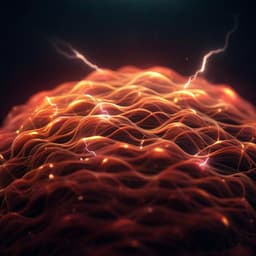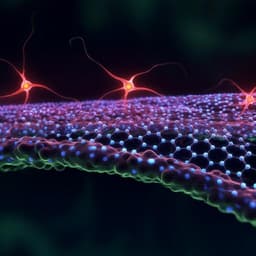
Medicine and Health
3D high-density microelectrode array with optical stimulation and drug delivery for investigating neural circuit dynamics
H. Shin, S. Jeong, et al.
Discover the groundbreaking research by Hyogeun Shin, Sohyeon Jeong, Ju-Hyun Lee, Woong Sun, Nakwon Choi, and Il-Joo Cho as they unveil a revolutionary 3D high-density multifunctional microelectrode array. This innovative device enhances our capability to monitor and modulate neural activities, paving the way for advanced in vitro studies in neural circuit dynamics.
~3 min • Beginner • English
Introduction
The study addresses how to precisely monitor and modulate neural activity within 3D in vitro neural tissues to reveal neural circuit dynamics and functional connectivity. Conventional 2D MEAs and prior 3D approaches lack integrated, localized stimulation and high-density volumetric recording needed to follow temporal evolution of network formation. The authors propose a 3D high-density multifunctional MEA that combines large-scale 3D extracellular recording with localized optical stimulation and microfluidic drug delivery, enabling interrogation of connectivity, synchronization, and synaptic latency within single-group and compartmentalized two-group 3D neural networks.
Literature Review
Previous in vitro neural models in 2D and 3D have shown spontaneous and burst activities and emerging synchrony as cultures mature, but measurement tools have primarily been planar MEAs with limited 3D access. A recently reported 3D MEA offered lower site density than needed for detailed volumetric mapping. Optical methods like two-photon imaging and optogenetics provide depth access but require complex setups, have limited fields of view and temporal resolution, and typically do not integrate with large-scale electrical recording. Multifunctional neural probes with microfluidics and optics have been demonstrated in vivo, but integrated 3D MEAs for in vitro tissues with both stimulation and monitoring remained unavailable. This work builds on microengineering of 2D multifunctional MEAs (with embedded microfluidic channels) and stacking strategies to realize a 3D high-density array.
Methodology
Device design and fabrication: The 3D MEA consists of three stacked 2D MEAs (fabricated via MEMS processes) forming a 3×6 shank matrix (row spacing 500 µm, column spacing 360 µm). Each shank carries 3–4 Pt electrodes (20×20 µm²) at the tip with 85 µm inter-electrode spacing. The overall neural tissue coverage is approximately 1.85×1×0.3 mm³ with a recording site density of ~33 sites·mm−3. One multifunctional shank integrates three embedded microfluidic channels (each 20 µm wide, 12 µm high) terminating at a 30×12 µm outlet under an embedded glass layer, and a thinned multimode optical fiber for light delivery. Stacking was performed by bonding differently sized 2D MEA bodies with epoxy to create a 3D array.
Packaging and interfaces: The 3D MEA was bonded to a custom PCB with wire-bonded pads and FPC connectors to an Intan 64-channel system. A PDMS microfluidic interface chip provided fluidic access. A thinned optical fiber (~60 µm diameter; GIF50) was aligned to the multifunctional shank and coupled to a small blue LED (Cree XQ-E), with UV-curable epoxy used as index-matching and blackened to prevent light leakage. Electrodes were electroplated with Pt-black to reduce impedance.
Characterization: Impedance of all 63 microelectrodes was measured by EIS in PBS (10 Hz–10 kHz). Long-term stability was assessed over 14 days at 37 °C. Microfluidic flow rates were measured under pressures 50–200 kPa in air, cell-free 0.25% w/v collagen, and neuron-seeded collagen (4×10^7 cells·mL−1). Optical output at the fiber tip was measured with a photodetector; Monte Carlo simulations modeled light distribution in collagen (absorption 0.3 mm−1, scattering 29 mm−1, anisotropy 0.89, refractive index 1.34; 0.15 mW at 473 nm, launch angle 21.9°).
Miniaturized incubator system: A stainless-steel microdrive enabled precise vertical positioning (0.3 mm per revolution) and held the 3D MEA over a PDMS culture chamber (well 2.5×1.5×0.5 mm³) within an acrylic enclosure (10×8×8 cm³) to minimize evaporation and contamination.
3D neural cultures: Primary rat cortical neurons (E18) were embedded in type I collagen (0.25% w/v), seeded at 4×10^7 cells·mL−1. Two models were used: (1) single-group network; (2) compartmentalized two-group network with two somatic regions flanking a central neurite region, created using 125 µm PET films to partition compartments during partial gelation (20 min intervals). The 3D MEA was loaded prior to collagen gelation to ensure uniform fibril distribution and minimal deformation.
Optogenetics and pharmacology: ChR2 (AAV-EF1a-hChR2(H134R)-eGFP) was expressed in neurons for optical activation. Local optical stimulation was delivered at 0.2 Hz, 50% duty cycle (2.5 s pulses) via the LED-coupled fiber. Excitatory synaptic transmission was blocked by local microfluidic infusion of CNQX (20 µM) and AP5 (50 µM), 1 µL at 0.25 µL·min−1 for 4 min, followed by 30 min diffusion; cultures were washed three times and stabilized for 1 h to assess recovery.
Organoid application: Human iPSC-derived spinal cord organoids (~700 µm diameter; ~3 months old) were interrogated with a needle-type MEA (16 electrodes with microfluidic channels). TTX (6 µM) was infused at 0.25 µL·min−1 for 3 min to suppress activity.
Electrophysiology and analysis: Daily recordings were performed in the incubator at 37 °C using Intan hardware (20 kS/s per channel; 300 Hz high-pass, 6 kHz low-pass). Spike detection used a threshold at ~3× noise (~50 µV). Burst analysis used ISI-threshold method (threshold 0.1 s; min 3 spikes). Synchrony between electrodes was quantified (PySpike) with scores 0–1; edges with score ≥0.5 were used for Louvain community detection. 3D network maps were visualized with custom code. Synaptic latency was estimated relative to optical stimulation onset by comparing spike time distributions across electrodes and fitting latency versus distance to extract transmission velocities.
Key Findings
- Electrode performance: Pt-black reduced impedance at 1 kHz from 1.761 ± 0.346 MΩ (bare Pt) to 0.015 ± 0.004 MΩ; stable over 14 days at 37 °C (day 1: 0.017 ± 0.004 MΩ; day 14: 0.018 ± 0.004 MΩ).
- Microfluidics: At 100 kPa, flow rates were 0.557 ± 0.007 µL·min−1 (air), 0.542 ± 0.011 µL·min−1 (cell-free collagen), 0.539 ± 0.015 µL·min−1 (neuron-seeded collagen), matching calculation (0.568 µL·min−1).
- Optics: LED luminous efficiency ~5.15%; LED optical output 51.5 mW per 1 W electrical input; fiber tip output 0.15 mW (coupling ~0.29%), yielding ~76 mW·mm−2 at tip. Simulation and measurement indicated irradiance >1 mW·mm−2 up to ~220 µm from fiber tip; stimulation remained localized to the shank tip volume.
- Single-group 3D network maturation: Spontaneous activity emerged by DIV 6 and increased through DIV 14 across electrodes. Significant increases noted in mean spike rate between DIV 10 and 11 (P=0.0102) and mean burst rate between DIV 10 and 11 (P=0.032). Number of active electrodes and burst metrics (duration, spikes/burst, ISI, IBI, % burst spikes) increased consistent with network maturation.
- Synchrony and network topology: Synchronization scores increased with time; number of networks (Louvain communities) peaked at DIV 9 then decreased as networks merged and node degree increased (P=0.002 between DIV 9 and 10), indicating maturation from local short-range to larger integrated networks.
- Optogenetic activation (single-group): At DIV 6, optical stimulation increased firing primarily near the multifunctional shank (P=0.0058 near shank; ns P=0.058 at other shanks). By DIV 14, stimulation increased firing both near the multifunctional shank (P=0.0072) and across other shanks (P=0.0080), indicating propagation via synaptic connectivity.
- Pharmacological dissection: After CNQX/AP5 infusion at DIV 14, spontaneous firing during LED-off was unchanged locally, but LED-evoked synchronization was restricted near the stimulation site; distant synchronization diminished (near other shanks ns P=0.0707). After wash-out, widespread synchronization recovered (significant P values restored near both regions: multifunctional shank P=0.0012; other shanks P=0.0005).
- Two-group compartmentalized model: Optically activating the first somatic region led to progressive recruitment across regions. By DIV 10, significant increases in firing at the stimulation site (P=0.0220), first somatic (P=0.0444), and second somatic (P=0.0436). By DIV 14, significant increases were seen in all regions including the neurite region (stimulation site P=0.0218; first somatic P=0.0229; neurite P=0.0214; second somatic P=0.0228). Extracellular action potentials were recorded in the neurite region (DIV 11–14), indicating propagation between populations.
- Synaptic latency and transmission velocity: At DIV 14, synaptic latencies between regions were 2–8 ms (excluding the directly stimulated site), with longer latencies at greater distances (e.g., ~6 ms within first somatic; ~8 ms to second somatic). Mean synaptic transmission velocities: overall (direction-agnostic) ~230 ± 42.6 mm·s−1; longitudinal 449 ± 106 mm·s−1; transverse 202.6 ± 69.8 mm·s−1; longitudinal significantly faster than transverse (P=0.0010), consistent with lower synaptic density along the neurite region compared to somatic regions.
- Human organoids: In human iPSC-derived spinal cord organoids probed with a 16-channel needle MEA, synchronized neural activity was detected across electrodes; TTX (6 µM) abolished activity and functional connectivity, demonstrating applicability for pharmacological testing in 3D human-derived tissues.
Discussion
The integrated 3D multifunctional MEA enabled high-density volumetric recording along with localized optical and chemical perturbations, directly addressing the need for precise tools to interrogate developing 3D neural networks. Progressive increases in firing, bursting, and synchronization confirmed functional maturation. Optogenetic stimulation exhibited local-only responses early and widespread responses after maturation, while pharmacological blockade confirmed that widespread activation was synaptically mediated. In the two-group model, the system resolved inter-group connectivity, tracked its emergence over time, and quantified synaptic latencies and direction-dependent transmission velocities, revealing faster propagation along a neurite-enriched longitudinal path. Compared to optical-only approaches (e.g., two-photon), the platform provided broader volumetric coverage and higher temporal resolution within an incubator-compatible, compact setup. The ability to modulate and record within 3D tissues, including human organoids, underscores the system’s relevance for mechanistic circuit studies and pharmacological assessments.
Conclusion
This work introduces a compact 3D high-density multifunctional MEA system that integrates large-scale 3D electrical recording with local optical stimulation and microfluidic drug delivery for engineered 3D neural tissues. The platform maps functional connectivity and network community structure during maturation, confirms synaptic mediation of activity, and uniquely quantifies synaptic latency and transmission velocity between compartmentalized neuronal populations. Demonstrations in human spinal cord organoids validate broader applicability. Future directions include scaling recording site counts, integrating on-shank µLED arrays and active microvalves for per-shank control, and incorporating CMOS-based MEAs and monolithic µLED arrays to expand spatiotemporal control. Applying the system in vivo and combining with advanced 3D imaging (e.g., tissue clearing) could further correlate structural and functional network organization.
Limitations
- Culture constraints: High cell seeding density (4×10^7 cells·mL−1) limited imaging depth (z-stacks ~100 µm) and culture duration (~14 days) due to nutrient demands; viral infection for ChR2 may slightly reduce spontaneous activity.
- Optical coupling: LED-based fiber coupling efficiency was relatively low (~0.29%) compared to laser-based systems, limiting optical power but favoring compactness.
- Scaling complexity: Expanding the number of multifunctional shanks is challenging due to optical (fiber/LED per shank) and fluidic (multiple pumps/tubes) interfacing; proposed solutions include integrating µLEDs and on-device active valves.
- Spatial coverage vs. density: Although site density (~33 sites·mm−3) is high relative to prior 3D MEAs, higher densities could further resolve subcellular propagation (e.g., axonal AP tracking).
Related Publications
Explore these studies to deepen your understanding of the subject.







